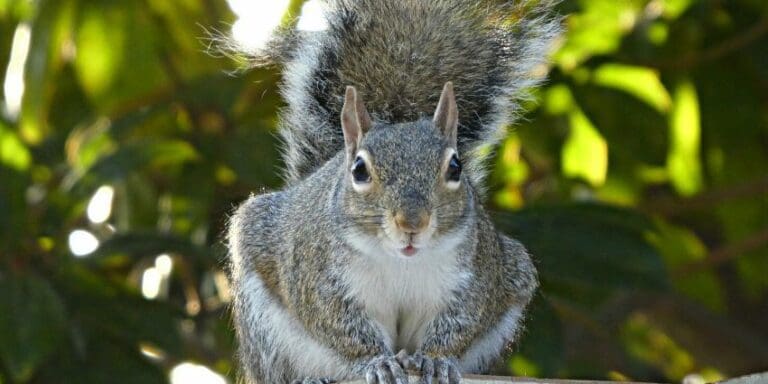Do Squirrels Carry Bubonic Plague? How to Protect Yourself
It’s a fact that might stop you in your tracks the next time you spot a squirrel scurrying through your garden: these furry critters can carry an ancient enemy – the bubonic plague. While it sounds like a relic from medieval history textbooks, I discovered that the question “do squirrels carry bubonic plague?” remains relevant today. Yes, squirrels, those ubiquitous creatures that inhabit our parks and backyards, have been identified as possible vectors for a disease that once ravaged continents and reshaped societies.

Do Squirrels Carry Bubonic Plague?
With squirrels being such a common sight, one might wonder about the bubonic plague risks from squirrels. After all, these animals appear rather harmless. However, as an inquisitive mind ought to know, appearances can be deceiving. Squirrel plague transmission, while not a daily headline, is a genuine concern. Particularly in areas like Los Angeles County, known for its diverse wildlife, cases have been reported where the unsuspecting rodents, alongside fellow chipmunks, play host to plague-bearing fleas.
And while modern medicine has significantly blunted the teeth of this old-world monster, the risks of delay or misdiagnosis make it clear that caution is more than just a historical footnote; it’s a modern-day necessity.
Key Takeaways
- The possibility that squirrels can be carriers of the bubonic plague.
- Los Angeles County’s wildlife, including squirrels, can harbor bacteria causing bubonic plague.
- Understanding the relationship between contact with infected fleas or pets and the transmission of the disease.
- The significance of early diagnosis and treatment with antibiotics.
- The importance of preventive measures to reduce the risks of squirrel-related plague transmission.

Understanding Bubonic Plague and Its Carriers
Traversing the annals of deadly pandemics leads us to confront the historical spread of bubonic plague, a dark shadow over humanity’s past. As I delve deeper, I find the thread that weaves through time, carrying this affliction from ancient civilizations to present-day wildlife, including our seemingly innocuous furry critters—squirrels.
Historical Perspective of Bubonic Plague
Stepping back into the corridors of time, one cannot escape the gripping tales of the Plague of Justinian or the horrors of the Black Death. Europe was the epicenter, where the plague snuffed out scores of lives, reshaping history. Centuries have lapsed, but the echoes of that historical spread of bubonic plague still resonate today as it sustains its existence within North American wildlife, often lurking silently within squirrel populations.

How Rodents and Fleas Spread the Plague
Squirrels trot alongside their rodent kin on the list of bubonic plague carriers. With rodents as prime reservoirs for the Yersinia pestis bacterium, it’s a sobering revelation to realize how rodent-mediated plague transmission affects ecosystems. In the rural idylls away from the bustle of human activity, outbreaks within squirrel communities signal a red flag to health officials, illustrating nature’s complex and sometimes perilous web.
The Role of Squirrels in Plague Transmission
The mention of bubonic plague in squirrels constructs a bridge between historic pandemics and current zoonotic risks. Insights from the Los Angeles County Department of Health Services draw a path of infection from the rural retreats to human habitation through direct contact and flea bites, with nature’s innocents becoming inadvertent agents of disease. Their role in perpetuating this cycle is pivotal, and understanding it is critical to containment and prevention efforts.
I’m mindful of the gravity these creatures, no larger than a loaf of bread, carry on their small shoulders. With each scurry and every leap, they can modify the disease landscape, making it incumbent upon us to learn, adapt, and coexist cautiously.
Squirrel-Borne Diseases and Public Health Concerns
As someone deeply interested in wildlife and public health, it’s my duty to shed light on the potential hazards posed by squirrel-borne diseases. Notably, understanding how do squirrels spread bubonic plague and the risks of squirrel-borne infections can significantly enhance our safety protocols when interacting with our bushy-tailed friends.
Identifying Signs of Plague in Wildlife
Monitoring wildlife, particularly rodents such as squirrels, for signs of plague is an essential component in safeguarding public health. Recognizing symptoms is paramount, as they hint at potential risks lurking within seemingly tranquil natural habitats. One remarkable outbreak site is the Tahoe Basin, where chipmunks have tested positive for the much-dreaded disease. Symptoms in our wildlife neighbors often mirror those in humans, notably including fever, nausea, and swollen lymph nodes, so an informed eye can be the key to early detection and prevention of a broader crisis.
Risks of Bubonic Plague from Squirrels
The quintessential question has been “How do squirrels spread bubonic plague?” And as I learned, these unassuming creatures can have much darker tales to tell. A squirrel testing positive for the bubonic plague in Colorado has forcefully reminded us that the risk of human infection from these adorable rodents is not just the stuff of historical lore. Both wildlife and pets can act as channels for this disease, making it a substantial concern for those engaging in outdoor activities.
Preventative Measures to Protect Against Squirrel-Borne Infections
Thankfully, there are practical measures that we can take to minimize the risks of squirrel-borne infections. El Dorado County and Jefferson County Public Health agencies rally for preventative strategies, which, if adopted diligently, can provide a strong defense against this ancient adversary.
- Minimize direct contact with rodents and their habitats
- Implement flea control for pets, reducing the chance of flea transfer
- Be vigilant of symptoms after possible exposure
- Seek immediate medical care if there’s any suspicion of infection
By respecting wildlife from a safe distance and adhering to these precautions, we can coexist peacefully with our squirrel counterparts while protecting ourselves from the diseases they could inadvertently spread.
The data accumulated leaves little doubt; squirrels, along with other rodents, can carry and transmit the bubonic plague, representing a not insignificant health risk to humans. This connection between squirrels and the plague underlines not just the virulence of the disease but also underscores the essential nature of implementing effective prevention measures. It’s clear that by limiting our contact with these wild animals, ensuring our pets are free from fleas, and maintaining a high standard of hygiene, we can appreciably diminish the prospect of infection.
Subscribe to the Free VIP Squirrel Scoop Insider Magazine
Written by none other than Bart the Balcony Squirrel, this lighthearted take on life and current squirrel-related world events is sure to bring a smile to your face. From his perch on the Kitty City Squirrels balcony, Bart brings a unique and entertaining perspective to every issue. Why wait, Subscribe now!
Fortunately, should the disease be promptly recognized, the availability of antibiotics stands as a mighty weapon in our arsenal against the plague. My recommendation is to heed the guidance of our public health departments diligently, as they play an indispensable role in both monitoring and curbing the outbreak of diseases. Their dedication to educating the public and executing targeted intervention strategies is crucial to the maintenance of our collective well-being.
So, as I remain vigilant in safeguarding my health against the potential bubonic plague risks from squirrels, I also take solace in the fact that by acting proactively and smartly, I am significantly reducing the chances of facing such threats head-on. It’s through our informed actions that we stand the best chances of preventing the spread of squirrel-borne diseases and ensuring that we, our families, and our communities remain safe.





